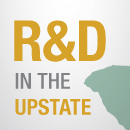The Truth about R&D in the Upstate
November 1, 2016 There’s more to Upstate research and development (R&D) than RPMs. Given our region’s success in creating an ecosystem for automotive manufacturing and research, it’s understandable that many people think of cars first when it comes to research and development. But the truth is that a great deal of R&D activity goes on unaccounted for in a variety of industries from medical devices to sporting goods.
There’s more to Upstate research and development (R&D) than RPMs. Given our region’s success in creating an ecosystem for automotive manufacturing and research, it’s understandable that many people think of cars first when it comes to research and development. But the truth is that a great deal of R&D activity goes on unaccounted for in a variety of industries from medical devices to sporting goods.Many miss the bigger picture of R&D in the Upstate partly due to the most commonly used economic development measures: capital investment and jobs. Government, economic developers, and ordinary citizens usually look to these two numbers to assess the impact of new or expanding businesses. The bigger, the better.But innovation can happen with just a few dozen people in a modest facility.Relying too much on staff and building size can exclude important growth in sectors whose economic impact can far outweigh their staff size and physical footprint. Industries of the present and the future – biotechnology, software, engineering and others – can often innovate with rather lean operations.One example is North American Rescue in Greer. The maker of emergency medical and rescue equipment has a staff well below 100 people, yet won a $107.2 million contract with the U.S. Department of Defense (DOD) just last month in October 2016. North American Rescue supplies military, law enforcement, first responders and other groups worldwide with equipment developed and tested at an unassuming facility visible from I-85. The DOD award was announced in defense and medical device news wires, but flew under the radar here at home.
Another company, Tetramer Technologies in Pendleton, conducts applied materials R&D for several global companies, as well as the U.S. Department of Energy and DOD. Having seen about 25 percent growth annually for 10 years, the company now has 30 employees and multiple million-dollar contracts. Tetramer grew out of the work of four Clemson faculty members and prides itself on maintaining that relationship through student mentorship and collaboration that has brought grant monies from the National Science Foundation to the school and company. They’ve even developed a fat replacement to be used in low-calorie chocolate that will hit the market next year.
What We’re Getting Right
That said, it’s partly due to progressive initiatives that foster R&D in the Upstate that there is so much activity to track.
Research Facilities
Although smaller innovators might not always get the attention they deserve, what they do have is a growing number of facilities dedicated to helping them do their work and accelerate their businesses.
In Anderson, for instance, corporations and startups are doing advanced materials applied research at the Duke Energy Innovation Center. Created by the South Carolina Research Authority, the center’s strategic location capitalizes on proximity to Clemson University’s Advanced Materials Research Laboratory, which provides resources for modeling applications and links to national research networks. The center has “state-of-the-art secure rooms for sensitive work,” according to SCRA, and the building itself is a LEED Certified, Gold Rated facility, underscoring the forward-thinking that happens there.
CU-ICAR and Automotive
R&D is also happening in larger-scale research facilities. Take the Clemson University International Center for Automotive Research (CU-ICAR), which recently opened its sixth building in the Technology Neighborhood I. A $14 million project, the four-story, 83,500-square-foot facility has R&D space, high-bay labs and flexible office space for industry innovators and entrepreneurs. Tenants in the new building include JTEKT North America Corp., a leader in automotive and industrial product solutions that chose the building for its North American headquarters; Clemson Computing & Information Technology; and the Risk Engineering and Systems Analytics Center of the College of Engineering, Computing and Applied Sciences.
On the program side, Clemson recently recruited “robotics rockstar” Venkat Krovi to serve as the Michelin Endowed Chair in Vehicle Automation. Krovi is charged with leading the university’s exploration of driverless automobile technology, which is nearer on the horizon than the average consumer might expect.
Krovi recently spoke about working closely with BMW’s Information Technology Research Center, too, which is located next door to his office. “As they say in real estate, ‘location, location, location,’” Krovi said. “The assets are in place. How do we start getting them to work together on interesting, challenging projects? I’m hoping that I’ll be able to work with all of them on exciting autonomous and connected vehicles projects.”
Bioscience
On the bioscience frontier, Greenville Health System’s Research Development Corporation is dedicated to the development, implementation and use of medical and healthcare delivery advancements created by physicians and researchers at the associated GHS Clinical University. As GHS’ technology transfer office, the RDC identifies, assesses and markets commercially viable technology developed by GHS physicians, faculty and staff (more familiar examples of such products include Gatorade, HIV vaccines and other blockbuster treatments). Additionally, the RDC manages the development of industry collaborations and assists in attracting new businesses and jobs to the region.
Courting Foreign Investment
There’s another practical reason to pay attention to the smaller innovators in the Upstate. Highlighting the middle market means showcasing potential targets for merger and acquisition (M&A) activity with foreign companies looking for soft landings. Those considering acquisitions would have a vested interest in learning about small-but-profitable innovators doing excellent work in the Upstate. At the same time, foreign firms that simply want to open satellite facilities or small offices have keen interest in R&D partners.
How to Supercharge Upstate R&D
At Upstate SC Alliance’s Global South Metro Exchange this summer, business and community leaders gathered from Atlanta, Charlotte, Charleston and the Upstate to discuss global business competitiveness. One session at the event tackled the question of how collaboration could grow R&D. Doug Kim, intellectual property attorney with Kim and Lahey Law Firm, laid out five sectors that should collaborate to create a robust ecosystem for innovation: government, multinational companies, research universities, small and medium-sized business. Private investors each have a key role, but lack a vehicle through which to connect. Kim suggested that:
- Multinational corporations take “orphan” patents off the shelf, licensing technologies to entrepreneurs who take them to market.
- Small businesses take advantage of abundant research capabilities and personnel – including MBA programs – at universities.
- Governments incentivize and fund cross-sector collaborations.
For example, one small company that asked Spartanburg-based Milliken for help developing fabric for athletic clothing eventually became Under Armour, a publicly-traded American sports clothing and accessories company that reported $3.96 billion in revenue in 2015. Kim and the audience then discussed real-world challenges and brainstormed solutions.
That kind of brainstorming should be ongoing. When pausing to look at what’s happening just below the surface, it becomes clear that the Upstate is fertile and productive ground when it comes to research and development.
